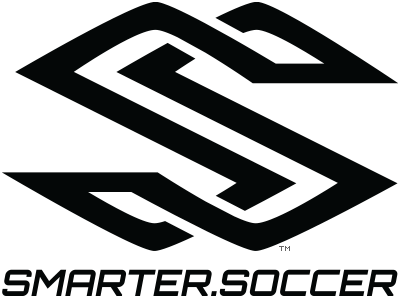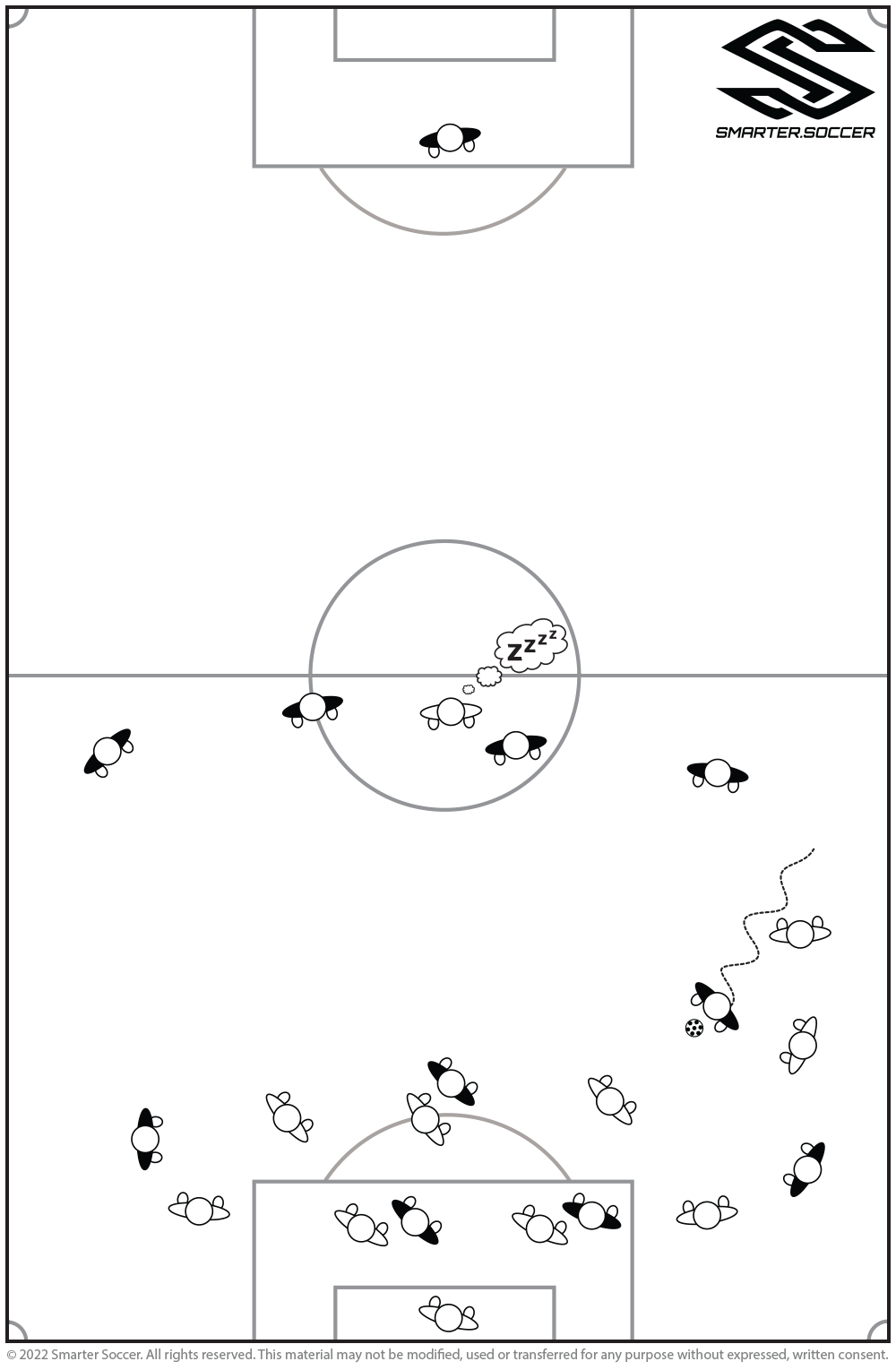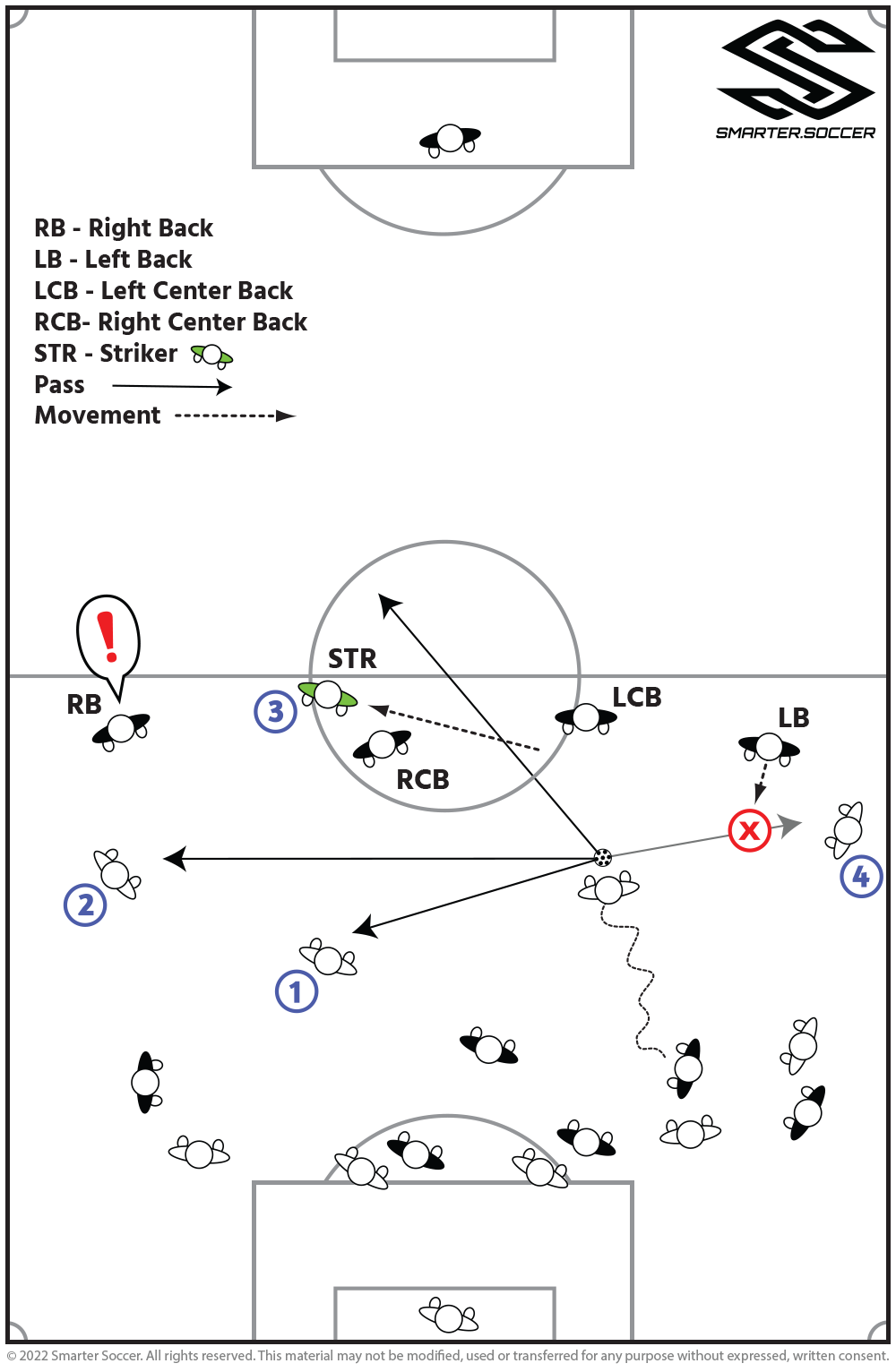ALWAYS BE AN OPTION
Based on the latest FIFA statistics, on average, a player possesses the ball in a 90 minute game for just under two minutes – one minute, 49 seconds to be exact. Just think about that for a moment. A professional soccer player only has the ball for 2% of the game. That’s hardly any time on the ball. Clearly, what they do with that small amount of time is essential, but you know what’s even more important? What they’re doing when they don’t have the ball.
“Off The Ball Movement” is the term that coaches use when they describe the actions a player takes when they don’t have the ball. If a player is active they are constantly moving and adjusting their positioning based on what’s happening on the field. If a player is inactive then they are usually standing still or walking. If a coach is pragmatic, they may refer to this as “watching the game, instead of playing the game.” If a coach is more brazen or salty they’ll say “he/she doesn’t run,” “they’ve switched off” or worse, “they’re lazy.” Don’t let this be you. Always be an option.
Soccer players who are always an option, never “switch off.” They are always examining and evaluating what’s transpiring on the field — reading the game — even when the ball isn’t near them. Using this game intelligence, they can present themselves as an option to a teammate who has the ball. This movement to receive the ball is critical for team success. Reason? Every player’s movement influences the game. We discussed how every action on the field causes a reaction in Soccer Is A Chess Game In Motion, so you can understand that players who are inactive, simply don’t influence the game.


Definition: Off The Ball Movement
How players move and position themselves on the field, when they don’t have the ball.


Or even worse, our same Striker’s midfield has gained possession and is marauding up the pitch on the counter attack. Instead, of making a slashing run to receive the ball into space behind the retreating defenders, our Striker has decided to position himself between the two opponent’s center backs with his back to the goal and wait for a pass. Any pass to the Striker will either be easily intercepted or immediately defended, resulting in the opponent regaining possession, or at best, the Striker playing the ball back to a midfielder. Playing the ball back slows down the play, allows the opponents to get players back on defense and kills the counter attack.
In both these scenarios, our “lazy” Striker has negatively affected the game by being inactive, and never being a quality option. Most capable coaches will react to this poor performance, no matter how skilled the Striker is, with a substitution. Coaches are always looking for hard-working, active players who can present themselves as an option with their savvy movement. Let that be you!
Being An Option Doesn’t Mean You’ll Receive The Ball
Being an option doesn’t always mean you’ll receive the ball, but it does mean your movement will influence the game. In the above example, if our Striker made that diagonal, slashing run to receive a through ball behind the defense, most likely he would have caused one of the Centerbacks to track the threat, dragging him out of position. Even if the Striker doesn’t get the ball, the movement has now opened up the center of the defense, creating space for the attacking midfielder to penetrate. The Striker’s run has created havoc and produced additional options for his team. The defense quickly went from organized, to “unlocked” with one Centerback man-marking the slashing Striker opening up space that the attacking team can exploit.

Where Can You Be An Option?
Where can you be an option on the field? Everywhere there’s space on the field and you’re in an open passing lane. In the example above, the space for the Striker to be an option was behind the defense. But pockets of space can also be found between opposing players on the same line – for example between the Left Midfielder and the Center Midfielder. As well as the space between the defenders and midfielders, and midfielders and forwards. There are even more areas of space on the field, but we’ll get into this in the future.. However, let’s take another look at the same scenario:

Who Is The Best Option?
Take a good look at the above Illustration- who is the best option for the player with the ball? Remember, the white players have just gained possession and are looking to breakout of their own defensive third.
➀ – Player 1 is certainly open and an option. But two things don’t make this the best choice. First, there are two opponents close to him. Second, the white team is on the counter attack, so playing the ball back to Player 1 defeats the purpose of breaking out and having a numerical advantage on the attack.
➁ – Player 2 is open, but not without risk. If the Right Back (RB) reads the pass, they may have the opportunity to intercept. However, if Player 2 can move to the ball and play a one-time through ball between the Right Back (RB) and Right Center Back (RCB), and the Striker (STR) stays onside, then this could be a viable play. But those are two big “if’s.”
➂ – Player 3 – your Striker (STR) – is slashing between the Left Center Back (LCB) and the Right Center Back (RCB) and is in the perfect position for a breakaway. Provided that player with the ball recognizes this Pattern Of Play and immediately delivers the Striker (STR) an angled through ball, this is the best option. Quiz: If the player with the ball passes it to the Striker at this very moment, is the Striker onside or offside? (Answer below)
➃ – Player 4 is definitely not an option, since he’s standing still and the Left Back (LB) could easily take one step and intercept it. However, what if Player 4 bolted down the sideline instead of just waiting for the ball? Well, that would open up a second through ball opportunity. The Player with the ball could split the Left Center Back (LCB) and the Left Back (LB) with an angled pass, and Player 4 could be off to the races.
Always Be An Option
Being an option – where there is space and you’re in an open passing lane – creates windows of opportunities for your team. But you must remember that these windows are only open for a small amount of time before an opponent’s movement causes them to close. Therefore, as soon as a window closes, you must move into a different space to be a new option. This movement in a soccer game never stops, which is why you must be active physically and engaged mentally at all times to make an impact.
A.01
Active Mind = Active Feet
If your mind is reading the game, your feet will be reacting to that intelligence.
Players who are actively engaged in the game are always moving on the field. If you find your mind drifting off and thinking about homework, Call Of Duty, what you’re going to eat for lunch, most likely you’ve stopped moving and are just a spectator. Get you body moving into a position to be an option.
Now I know what you’re going to say: I’m a Left Back and our Right Wing is bombing up the sideline towards the opponent’s corner flag; why do I need to do anything? Well, you certainly don’t need to run around like a headless chicken, but you should be asking yourself “What if?” as the ball progresses down the field and change your position instantly. Now is not the time to switch off because in a flash your Right Wing could make a lousy pass that gets intercepted by the opponent’s Center Midfielder. The Forward on your side of the field immediately recognizes that the counter-attack is ON and makes a slashing run, hoping to exploit your decision to take a nap.
Active Feet = Active Mind
★ Smarter.Soccer Insight: Do you have ADHD and find your mind drifting off when you’re playing? You’re certainly not alone. In some cases, players with ADHD may find that the opposite is helpful: Active Feet = Active Mind. Keeping your feet active, may help you stay engaged. Try it!
